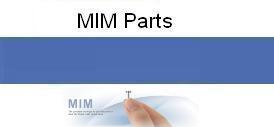|
|
FAQs |
1.
What is MIM technology?
MIM (Metal Injection Molding) is a manufacturing technology that combines the
shape making complexity of Plastic Injection Molding with the material
flexibility of Powder Metallurgy.
2. How does the MIM process work?
Fine metal powders are combined with thermoplastic and wax binders to form a
feedstock. When heated, the feedstock becomes a viscous slurry which is then
injected under high pressure into an engineered mold to form the desired shape
component. Upon cooling, the part is ejected from the mold and then subjected to
a process (called “debinding”) to remove binder constituents. The final step
(sintering) subjects the part to high temperature in a controlled atmosphere to
fuse the metal powders together into a near fully dense solid.
3. Is the metal melted during the molding process?
No, only the binders are melted allowing the powders to flow like a plastic
material. Upon cooling the binders solidify giving the part strength for
handling. The part must be subsequently sintered to high density to achieve the
required mechanical properties.
4. How does MIM differ from the Conventional PM process?
Conventional PM uses high, uniaxially applied pressure to coarse metal powders
in a die set to produce moderately complex components. Typically, no further
densification is gained during the sintering process. Densities achieved by this
method are typically in the range of 80-90% of theoretical which limit the
physical properties that can be achieved for the given alloy. MIM products are
not limited in shape complexity due to the flexibility of the injection molding
process. The fine metal powders used - combine with higher sintering
temperatures to allow MIM to achieve near full density in the final article.
This allows MIM products to have similar properties as wrought materials.
5. Does the part shrink during removal of binders?
No, the part will not change size in the debinding phase of the process.
However, since sintering achieves near full density of the powders, the part
will undergo a size change of up to 20%.
6. What will be the density and strength of the MIM parts?
Typical MIM densities achieved are ≤ 96% of theoretical. Properties vary
depending upon the alloy chosen however they will be similar to wrought
material.
7. Why should I use MIM?
MIM excels in producing small, highly complex parts that are difficult or cost
prohibitive to produce with conventional technologies such as machining or
casting.
8. What materials can be manufactured?
Almost all kinds of metal alloy can be used in the MIM process. Typical alloys
include high strength steels, stainless steels plus Ni and Co super alloys.
Other materials processed include refractory metals, titanium and copper alloys.
Low melting point alloys like brass, bronze, zinc and aluminum are possible but
not usually economically viable by the MIM process. Check the Jiangsu Tech materials
selection chart for the full range of MIM materials processed.
9 What is the best way to realize the benefits of MIM?
The best way to realize the full benefits of MIM is to apply the technology
early in the design phase in your product development cycle. Jiangsu Tech will
assist you in the application of MIM whether it is a new component or a
conversion from an existing metal forming technology.
10. What is the lead-time required for MIM?
Typical lead-time for tool building and sample submission is 8-10 weeks.
However, shorter lead-times are possible depending upon the specific project
requirements.
11. What is the typical annual quantity in MIM?
Generally, production volumes will need to be in excess of 20K pieces annually
for a typical product. However, Jiangsu Tech will consider any annual production
volume that will be economical viable for the customer.
12. Is there a rule for defining complexity?
There is nothing right or wrong here. As a thumb rule, if a drawing has more
than 20 dimensions – it may be a good part for MIM.
13. Are there any limitations in MIM?
As with any technology, MIM has limitations. Product weight is limited to a
maximum weight of about 240 grams (although economics generally push the weight
limit to no more than 50 grams). Certain geometrical features can also present a
problem (like extremely thin or thick cross sections). Jiangsu Tech will advise the
best design options to suit your requirements.
14. What kind of tolerances can MIM achieve?
Typical MIM tolerances range from ± 0.3% to 0.5% of the dimension. However,
tolerances are highly dependent upon product geometry. Tolerances beyond what
MIM is capable of are achieved by post machining operations. Jiangsu Tech will help
you with this analysis and can provide a full range of in-house machining
options to supply a product that meets you requirements.
15. What kind of equipment is used in the MIM process?
MIM technology typically uses off the shelf machinery with proprietary
enhancements. Jiangsu Tech uses state-of-the-art machinery with the latest
controls for maintaining superior process output. Jiangsu Tech has built a strategic
relationship with many of its US and European equipment suppliers to customize
their machinery to our specific requirements.
16. Can MIM parts be heat treated or plated?
Yes, MIM parts can be heat treated & plated as done on a conventional machined,
cast or forged product. Jiangsu Tech maintains in-house heat-treating and plating
facilities to supply fully finished components.
|
|
|
|
|
|
|
|
| |

